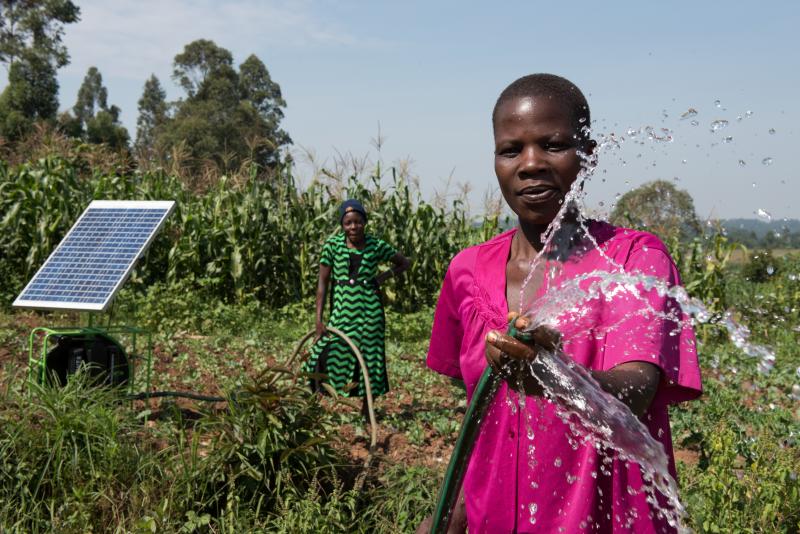Solar energy can not only address Africa’s problem of electricity, but also have a major impact on scaling food production and safeguarding food security. But that requires a much more integrated approach that bridges the current divide between the agriculture and energy sectors.
Many countries in Africa produce surplus power even as many industries like agriculture, which takes place in remote rural areas, remain under-powered or without energy access altogether. Decentralized renewable energy solutions, like mini-grids, are emerging as a solution.
What are mini-grids?
Mini-grids, or microgrids, are small, localised power plants and transmission that provide electricity for homes, local business and industry. They operate in isolation or together with national electricity transmission networks.
Solar energy can also play an important role in powering cold storage. Well-designed solutions, like Inspira Farms, take electricity generated when the sun is shining (or when the grid is up) and turn it into stored cooling potential for later. Inspira Farms has been delivered to dozens of export and agricultural trading customers across East and Southern Africa. Recently, Inspira Farms rolled out super-efficient off-grid cold storage units in partnership with the Rwandan Government. These units use 70% less energy than traditional systems, have thermal backup capacity, and are expected to benefit as many as 100,000 rural smallholder farmers as they seek to become connected to larger markets.
Energy solutions such as these have significant implications for reducing post-harvest loss (i.e. food waste) and the associated loss in farmer’s income, squandered resources (inputs, soil nutrients, water), major environmental impacts (including heat trapping emissions), and a loss of nutrition and food security for so many people across Africa.
Comprehensive business models that leverage technological innovation to add value to farming are critical, as is generating more data that allows governments (agriculture and energy ministries alike) to best identify the right power solution for a given context. Without it, farmers, agribusinesses, governments, and others will not know where to invest in the sector. But this data needs to be contextualized, analysed, and put into action by competent and effective private and public actors.

Microgrids, for example, have the potential to be the fastest and most effective way to deliver electricity to farming communities. However, they often struggle when they cannot find large consumers of electricity. Data will allow governments to coordinate with private mini-grid developers to identify regions where the construction of decentralised electricity infrastructure is required to match commercial, tradeable agricultural activity (including processing and cold storage).
Or consider the question of irrigation: there are many initiatives promoting solar irrigation that have struggled to reach commercial scale. This is, in part, because it is rare that pump providers truly know where their customers are. Learnings from this analysis by Apollo Agriculture mapped farmer location, infrastructure (water line and electricity connection), crop type, irradiance (i.e. sunshine maps), and hydrology and water resources to identify where farmers need irrigation. This information can also be matched with credit scoring information that is specific to farmers.
The opportunity for renewable energy-driven agriculture in Africa is possible. Greater inter-sectoral coordination, greater public-private partnership and greater innovation and data are required to seize it.
Want to learn more about renewable energy mini-grids?
- Watch #MaMoWebinar on “Renewable energy in African Agriculture”
- Have a read through the PULSE report
- Watch this short video Mini-grids: powering the next green revolution
- Check out MaMo Panel’s report Energized
- Flick through World Bank’s Mini Grids for Half a Billion People: Market Outlook and Handbook for Decision Makers
Photo credit: IWMI and www.jeffreymwalcott.com



 #Biodiversity is the backbone of...
#Biodiversity is the backbone of...



 Dear Ms. Swazi (@BSTForAfrica),...
Dear Ms. Swazi (@BSTForAfrica),...


 with @GlobalPulsesGPC & Singapore Tourism Board, and sharing how @BeansisHow is building knowledge to shape bean-friendly food policy. Onwards with action!
with @GlobalPulsesGPC & Singapore Tourism Board, and sharing how @BeansisHow is building knowledge to shape bean-friendly food policy. Onwards with action!  #BeansisHow
#BeansisHow 
 #RomeNutritionWeek2025 will spotlight the...
#RomeNutritionWeek2025 will spotlight the... 27 May | 14:00–15:15 CEST
27 May | 14:00–15:15 CEST WFP HQ & Zoom
WFP HQ & Zoom

 Did you know that tea is one of the world’s...
Did you know that tea is one of the world’s... From farm to cup, tea empowers—especially women—by boosting economic inclusion and building resilience in rural areas.
From farm to cup, tea empowers—especially women—by boosting economic inclusion and building resilience in rural areas. Fun fact: 60% of the world’s tea is grown by smallholder farmers!
Fun fact: 60% of the world’s tea is grown by smallholder farmers!


 Live now at #WHA78!
"#Healthsystems can help...
Live now at #WHA78!
"#Healthsystems can help...

 1 mln children die from wasting each year that could be prevented through strengthened health systems.
1 mln children die from wasting each year that could be prevented through strengthened health systems. 
 Join our Healthy Diets/Agroecology Coalitions event on "How to enhance policy coherence towards delivering Healthy Diets from Sust. Food Systems through agroecological practices"
Join our Healthy Diets/Agroecology Coalitions event on "How to enhance policy coherence towards delivering Healthy Diets from Sust. Food Systems through agroecological practices"  27 May, 11:00 - 12:15
27 May, 11:00 - 12:15  Zoom link:
Zoom link: 